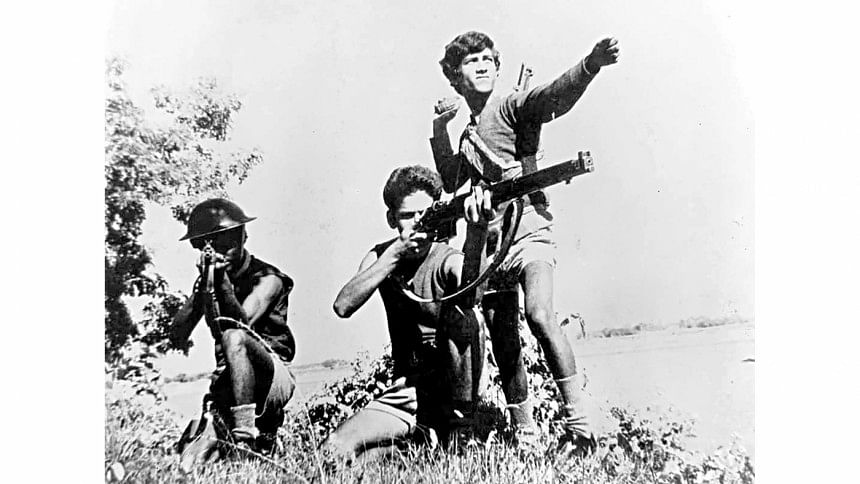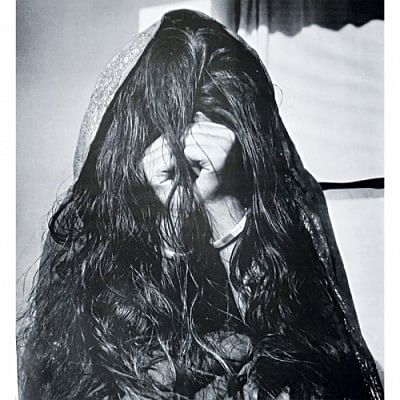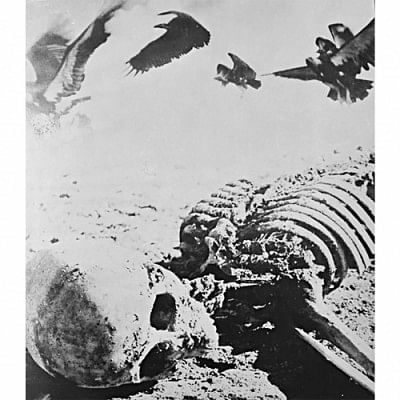A legacy at risk of fading away


Even though Naib Uddin Ahmed was an internationally renowned photographer, memories of his work are slowly fading in the minds of his own people in Mymensingh.
His camera has preserved some of the most striking scenes from the Liberation War -- scenes of torture, aggression, and grave injustice. Yet, only a few of his colleagues, well-wishers, and family members remember the veteran behind the lenses today.
Some of his photographs are widely used on different occasions, but his name is never seen on the credits. "It's quite painful for us," said Mahmuda Nasrin Kajol, Naib's daughter-in-law.
One of his most popular works, the historic photograph "Three Freedom Fighters", is displayed at the main corridor of the Ministry of Liberation War Affairs, but it does not bear Naib's name, lamented Kajol.
"We contacted Tobarak Hossain Ludu, then commander of Mukti Bahini in Singair, and the ministry concerned on various occasions, but no one took steps to recognise Naib as a freedom fighter. We want nothing but his recognition," she said.

Born at Paril Nauda village in Manikganj's Singair upazila in 1927, Naib, also known as Manik Mia, was the elder brother of eminent photographer late Dr Noazesh Ahmed. In 1961, he joined the Public Relations and Publications Department of Bangladesh Agricultural University (BAU) as its chief photographer, and served there for 30 years.
After retiring in 1990, he left Mymensingh for Dhaka in 1998. He died on December 14, 2009.
Soon after the war started, Naib and his family took shelter at Munshibari of Char Horipur and Parulitola village in Mymensingh for around four months. He spent those difficult months taking snaps of the war. He later returned to his BAU residence when normalcy returned.
With great risk, he captured images of intense brutality unleashed by the Pakistan army, said colleague Md Nowab Ali, who joined the department as Naib's deputy in 1968.
"His photographs helped publicise the war to the world, and they now survive as documents of the Liberation War," said Nowab, now 78-year-old.
Before the war, Naib used to visit adjacent villages on the other side of the Brahmaputra to capture images of rural life as a hobby. His lively and impressive photographs highlighted the diverse beauty of Bangladesh and its natural environment, recalled Nowab, who would accompany him sometimes.
It was his immense courage that led Naib to turn his camera towards the war. His photography captured the atmosphere of the war, like his photos of vultures circling carcasses on the bank of Brahmaputra, said Nowab.
A true patriot at heart, Naib would risk his safety to bring stories from the war to light. Daughter-in-law Kajol recalled a particular incident. "One day, my father-in-law told me, a Pakistan army officer asked him to take a look at his camera as it was not working properly."
"The camera was fine, but he (Naib) pretended there was something wrong with it. He asked the officer to send the camera to his office so he could try to fix it."
The following day, Naib took the reel out of the camera and replaced it with a damaged one. He then told the officer that the camera was fine, but the reel was so damaged that no photographs were found.
He later printed the photographs, which were taken at Tangail's Madhupur by the Pakistan army. The photos showed the army's barbaric torture on locals and their trail of destruction, Kajol said.
Freedom fighter Bimol Paul said Naib managed to send some of the photographs to Col Abu Taher, commander of Sector No-11. Taher, with the help of local Buddhijibi Sangram Parishad members, managed to send the images to India, concealing them in cartons of medicines meant for injured freedom fighters.
One of the photographs made its way to the Washington Post. Its depiction of a rape victim compromised the occupying force's claim of "normalcy", as the image exposed the general atmosphere of terror that prevailed.
Following the war, Naib went on to have a successful career. Numerous solo exhibitions of his photographs took place in and outside the country, including in India, Sri Lanka and Pakistan.
He also established Alokchitra Shilpi Sangsad (Ashis), a forum of amateur photographers in Mymensingh city, in 1978, which has a good collection of his photographs including ones taken during the war.
"We're lucky that we had the opportunity to take lessons from Naib," said Ashis secretary AHM Motalab.
There are several publications on Naib's photographs, including "Amar Bangla", which came out in 2009. The audio-visual centre of the Liberation War Museum has made a documentary titled "71: In Frame and Out of Frame", celebrating the photographer's works during the war.
The maestro achieved many awards for his brilliant work, like Pakistan's Best Picture Award in the World Photo Contest, United Nations Award, Unicef Award, Pravda Award, Unesco Award, and Life-time Achievement Award by Drik Picture Library.
Prof Md Anwarul Islam, former vice chancellor of Bangladesh Agricultural University, said Naib's photographs on the war have aesthetic and historical value, and they should be preserved as national treasures.
"Naib deserves national recognition for his life's work," opined Prof Anwarul.

 For all latest news, follow The Daily Star's Google News channel.
For all latest news, follow The Daily Star's Google News channel. 



Comments